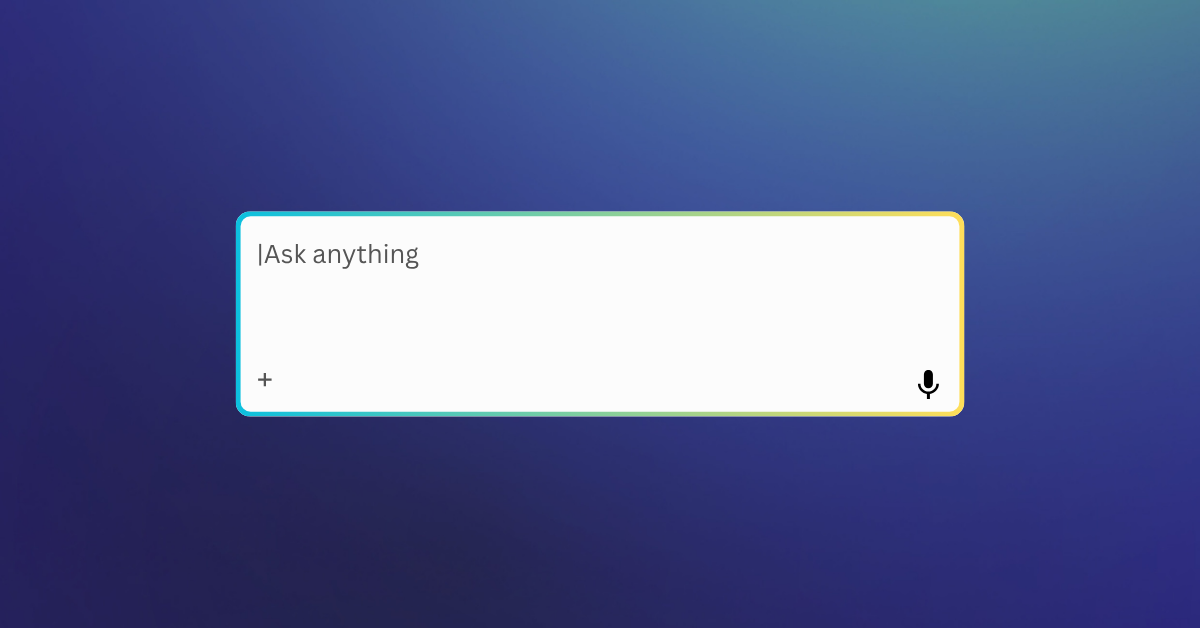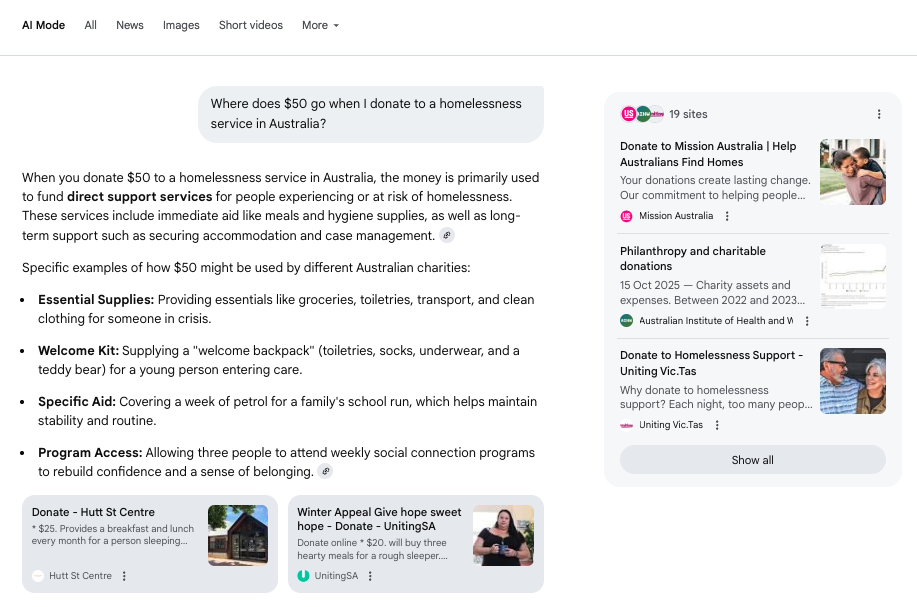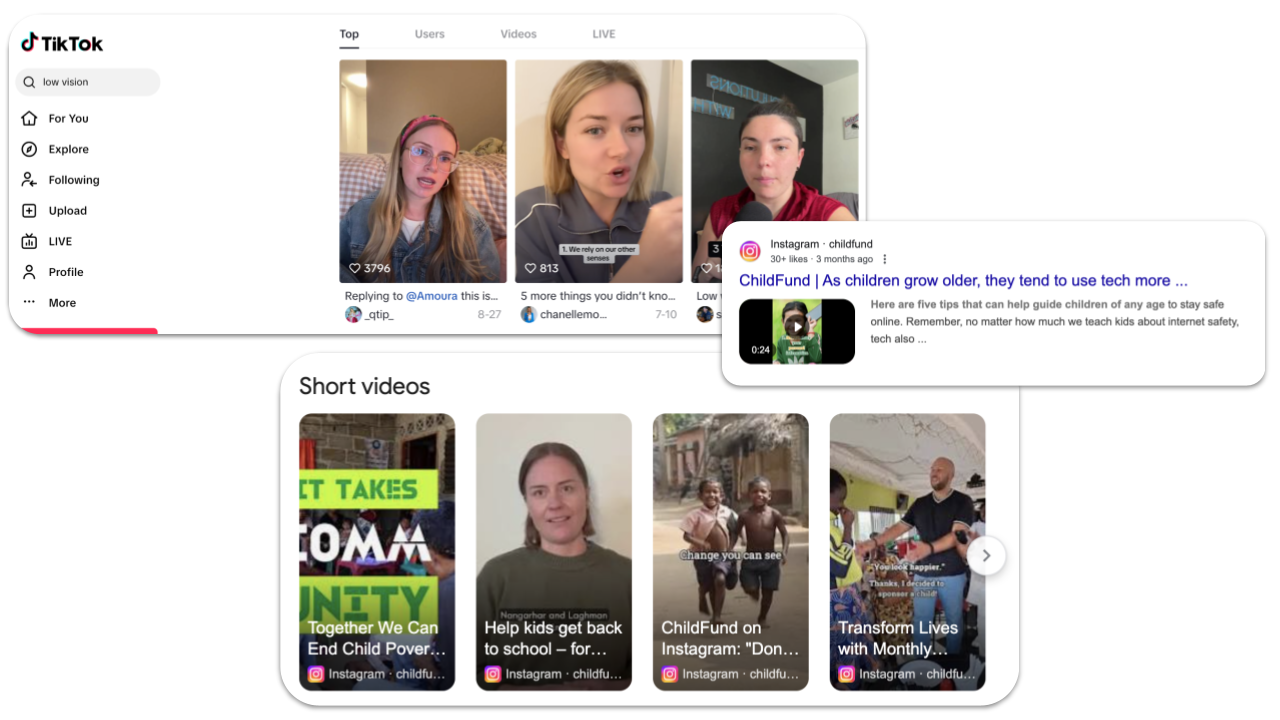How donor discovery is being rewritten by AI and key actions to prepare for 2026

This article was originally published on F&P.
The way people find charities online is changing, and fast.
Google is evolving from a “search engine” to an “answer engine”. Moving from a platform that shows you a list of links, to one that is a curator of knowledge. With AI summarising and telling you who to trust. What’s worth your time. What not-for-profit is most impactful. And where to give.
And that’s a game-changer for digital fundraising.
What’s happening, and why it matters
Google’s new AI Overviews and even newer AI Mode (which summarises the answers and removes pages of search result links to scroll through) is already live in Australia. It answers users’ questions directly in the results page, pulling insights from across the web, without donors needing to click through to your website at all. And that’s just one part of the evolution, with donor discovery happening across other interfaces like ChatGPT too.
The data? It’s clear…
Click-through rates through to websites from search results are down 34% due to AI summaries (AHREFs)
Cost-per-click for Google Grant ads is up 50% across ntegrity clients due to AI summarising informational searches
Search visibility is now decided by more than your website, with platforms like Reddit, YouTube, and even TikTok captions being indexed by Google
But Google also reports a 10% increase in search volume on questions and informational searches…which is a BIG increase on the 41 billion searches they get everyday
What this means: Your website traffic may be dropping, Google Grants and Paid Search cost-per-click may be more expensive, but your opportunity to connect with donors hasn’t disappeared, it’s just changing. So while donors may be skipping research steps, shrinking shortlists and letting AI do the early legwork, there are also new opportunities to reach and deepen your connection with donors.
Four moves to make your fundraising AI-ready in 2026
If your fundraising in part relies on people finding you online, then it’s time to rethink what “discovery” means. Here’s where to start…
1. Write for questions, not just keywords
Donors are no longer searching “donate to kids charity”. They’re asking:
“Which charities are actually making a difference for kids in poverty?”
“Where does $50 go when I donate to a homelessness service?”
And AI listens for answers that respond directly to what people are asking.
To show up, your content needs to answer real donor questions, clearly and confidently. Start with FAQs from your supporter services team, or use Google’s “People Also Ask” to find what donors care about.
Then structure your content around the problems they are trying to solve or questions they are seeking answers for, rather than just keywords. Give evidence, impact, and clarity in plain language. And make your landing pages feel like conversations.
For example:

2. Create content AI can actually see
AI isn’t just crawling blogs. It’s pulling from videos, podcasts, infographics, captions, and even comment sections.
The more content types you publish, the better your chances of being surfaced in answers.
Here’s what works right now:
Explainer videos on YouTube to distil your mission
Infographics and carousels that visualise impact and are easy to cite
Donor stories and interviews that boost credibility and emotional connection
Short-form reels or TikToks that answer donor FAQs in seconds
Podcasts and webinars that showcase depth and authority
Ask: “If a donor searched this topic, would we show up, and would we be memorable?”

3. Build trust everywhere (not just your website)
AI forms its “opinion” of your brand based on everything it can find. That means your reputation isn’t just what you say, it’s what others say about you, too.
To build trust signals that AI (and donors) will notice:
Invest in PR and partnerships that get your name into trusted media
Encourage reviews (e.g. Google Business) from supporters
Engage where your donors are — Reddit, Instagram, TikTok
Respond to reputation risks early and openly
Use brand ambassadors to tell your story on podcasts or panels
This is where marketing and fundraising must align. Fundraisers bring the impact. Marketers make sure it’s seen, shared, and cited.
4. Update your KPIs for the new AI reality
Clicks and web traffic aren’t the only signals that matter anymore, and in many cases, they’re decreasing.
Instead, start measuring:
Start tracking your AI visibility. AI search results are starting to show up in SEO tools and we recommend using them! See which of your pages are being pulled into Gemini or ChatGPT, what queries you’re showing up for, and where the gaps are. This is your new visibility baseline.
Add “AI mentions” to your KPIs. For brand awareness and engagement goals, being mentioned in an AI summary is a win. Make it a metric, especially for your upper-funnel campaigns.
Keep an eye on how your brand shows up across the web. PR, partnerships, media mentions, even Reddit threads all shape how AI perceives your credibility. Monitor brand citations and reputation across platforms.
Move beyond traffic as your north star. As search clicks decline, focus on the actions that actually matter: leads, donations, and revenue. This also means that your Google Grant account should be looking beyond spend as a key KPI.
The final word: Trust still drives giving
Yes, search is changing. But the fundamentals still hold.
Donors give to organisations they trust.
They give when your cause is easy to find, and even easier to understand.
They give when your brand is present, human, and credible, across every channel, every touchpoint, and now, every AI result.
If you need help rethinking your digital strategy for the age of AI, we’d love to chat.